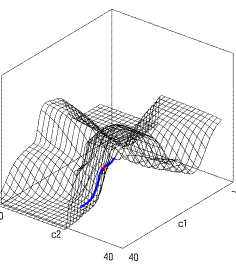Starting from January 2020 I will be successfully updating the content to incorporate the newest research.
MKNN - Mirek Kordos Neural Networks
MKNN is a software I created for learning and analyzing properties of MLP networks.
The three last pictures to the right were generated with this software.
MKNN home page
Self Organizing Maps
I am fascinated with SOM for two reasons:- It really works!
- The number of architectures and the possibility of creating new ones is really astonishing.
Visualization of learning in neural networks
- M. R. Gallagher - a PhD Thesis on Multi-Layer Perceptron Error Surface
- W. Duch - Visualization of hidden node activity in neural networks
- also my PhD thesis
Rule extraction from neural networks
- J. Neumann - a good paper about rule extraction from neural networks The paper was written in 1998 and therefore it unfortunately does not cover the newest techniques.
- R. Setiono - some methods of rule extraction from neural networks trained for classification and regression
Tutorials and introductory papers
(Almost) All Machine Learning Open Software
A Periodic Table of Visualization Methods
Jonathan R. Shewchuk in
"Introduction to the Conjugate Gradient Method Without the Agonizing Pain"
wrote: "When I decided to learn the Conjugate Gradient Method (CG), I read four
different descriptions, which I shall politely not identify. I understood none
of them. By the end of the last, I swore in my rage that if I ever unlocked the
secrets of CG, I should guard them as jealously as my intellectual
ancestors."
Some tutorials and introductory papers that I was able
to understand:
- First some basic Introduction to Neural Networks and Artificial Intelligence by John Bullinaria.
- Richardo Gutierrez-Osuna, "Introduction to Pattern Recognition".
- W. Duch, R. Setiono, J. Zurada, "Computational Intelligence Methods for Rule-Based Data Understanding"
- ATKOSOFT, "Survey on Visualization methods and software tools"
- Glenn Fung, "AComprehensive Overview of Basic Clustering Algorithms"
- Christopher J. C. Burges, "A Tutorial on Support Vector Machines for Pattern Recognition"
- Jan Depenau, "Automated Design of Neural Network Architecture for Classification", PhD Thesis, describes network generalization issues
- A. Piegat, "Modelowanie i Sterowanie Rozmyte" , EXIT, Warszawa 1999
High dimensional spaces
Here you can find the Presentation on Visualization of Mutidimensional Spaces
MLP networks typically contain hundreds of weights. This fact means that the error surface
is a surface of very high dimensionality. It is however not difficult to imagine the
properties of the spaces, using a simple extrapolation from 1,2 and 3-dimensional spaces.
First, as the dimensionality N increases, the ratio of a volume of hypercube to the
volume of a hypersphere inscribed in it grows to infinity. (It is 1 for one dimension,
1,27 for two dimensions, 1,91 for three dimensions and so on). Thus more and more
of the space is concentrated in its corners.
Another effect is that the angle between diagonal and coordinate axes asymptotically
approaches 90 degrees, as N increases (its 0 for one dimension, 45 for two dimensions,...).
More information can be found in the paper
"The Curse of Dimensionality"
It is also getting more and more difficult to find parallel
directions (or the proper direction) in multidimensional spaces, when the dimensionality grows.
(Therefore it is difficult to train big neural networks even if there are no local minima).
I tried to write a simple program to demonstrate this phenomenon.
source code
There is somewhere a bug which I cannot find (either in the program or in my imagination),
because the program results and my imagination converge not to the same values.
Find the bug and I will send you a 300g Milka Chocolate.
Creative Commons License. You are free to copy, share and adapt all articles and software from my web page for noncommercial purposes, provided that you attribute the work to me and place a link to my home page. What you build upon my works may be distributed only under the same or similar license and you may not distort the meaning of my original texts.


